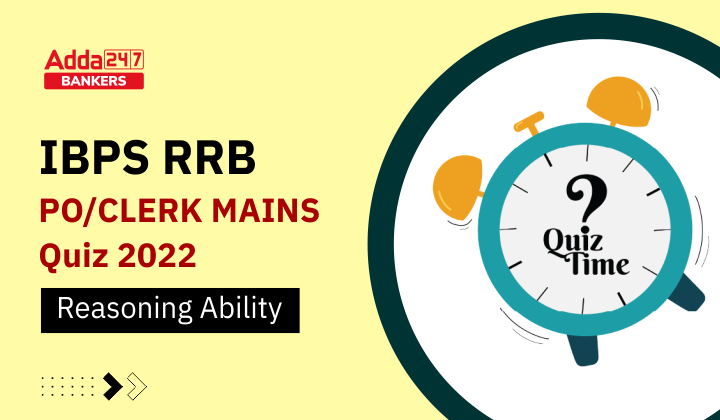Directions (1-5): Study the following information carefully and answer the questions given below:
Eight persons, A, B, C, D, E, F, G, and H are sitting in a straight line (but not necessarily in the same order). Three of them are facing south and rests are facing north direction. They all have their lucky numbers i.e., 12, 13, 37, 47, 52, 17, 25, and 18 (not necessarily in same order).
F sits right of C. E’s lucky number is a prime number. G and E face opposite direction. C’s lucky number is average of E’s lucky number and F’s lucky number. B sits third from the extreme end of the row. H’s lucky number is at least less than two numbers among all the given numbers. C doesn’t face north direction. G is an immediate neighbor of C and E both. B faces south direction. B’s lucky number is less than G’s lucky number but greater than H’s lucky number. D sits 2nd to the right of G. C sits immediate left of B. H sits 3rd right of C. The one, who sit at one of the extreme ends, has lucky number is a prime number. Both persons who sits at extreme ends face same direction. All the persons who sit left of D, those lucky numbers are less than the lucky number of D who face north. E’s lucky number is greater than at least three numbers among all the given numbers. The one whose lucky number is 17 doesn’t sit, immediate right of D and immediate left of F. H sits left of F. E’s lucky number is not second highest. A’s lucky number is a prime number.
Q1. Who among the following is second to the left of the one whose lucky number is 52?
(a) The one whose lucky number is 13
(b) Both (c) and (e)
(c) G
(d) None of these
(e) The one whose lucky number is 18
Q2. What is the lucky number of C?
(a) 12
(b) 47
(c) 37
(d) 25
(e) None of these
Q3. Who among the following sits third to the right of the one whose lucky number is 25?
(a) B
(b) C
(c) A
(d)H
(e) None of these
Q4. What is the position of F with respect to the one whose lucky number is 37?
(a) Second to the left
(b) Third to the left
(c) Second to the right
(d) Fourth to the right
(e) None of these
Q5. C faces in which direction?
(a) North
(b) South
(c) Same as D faces
(d) Both (a) and (c)
(e) Cannot be determined
Directions (6-10): A number arrangement machine when given an input line of numbers, rearranges them following a particular rule in each step. The following is an illustration of input and rearrangement.

Step IV is the last step of the above arrangement as the intended arrangement is obtained.
As per the rules followed in the given steps find out the appropriate steps for the given input:
Input: 11 48 83 36 45 64 27 52
Q6. Which of the following will be Step III for the above input?
(a) 13 4 22 0 21 3 22
(b) 13 4 22 0 22 3 21
(c) 13 4 22 1 21 3 21
(d) 13 4 22 0 21 3 21
(e) None of these
Q7. Which of the following is 2nd from the left end in last step?
(a) 1.5
(b) 0
(c) 2
(d) 6.5
(e) None of these
Q8. What is the sum of the numbers which is 3rd from the right in step 1 and 2nd from the left in last step?
(a) 194
(b) 34
(c) 267
(d) 65
(e) None of these
Q9 What is the difference between the numbers which is 3rd from the right in step 3 and 2nd from the left in step 2?
(a) 9
(b) 4
(c) 12
(d) 6
(e) None of these
Q10.How many numbers are exactly divisible by 3 in step 1?
(a) Two
(b) Four
(c) Five
(d) Six
(e) None of these
Directions (11-12): In the following questions, the symbols %, &, @, $ and * are used with the following meaning as illustrated below.
‘A % B’ means ‘A is not smaller than B’.
‘A & B’ means ‘A is neither smaller than nor equal to B’.
‘A @B’ means ‘A is neither greater than nor equal to B’.
‘A $ B’ means ‘A is neither greater than nor smaller than B’.
‘A * B’ means ‘A is not greater than B’.
Now, in each of the following questions assuming the given statements to be true, find which of the four Conclusions I and II given below them is/are definitely true and give your answer accordingly.
Q11. Statements: A&S$O, P*L&O, D$A*F
Conclusions: I. F%D
II. S&P
(a) Only II is true
(b) Both I and II is true
(c) Only I is true
(d) Either I or II is true
(e) Neither I nor II is true
Q12. Statements: K&F*J$G&L&O%M@R
Conclusions: I. J&R
II. G%F
(a) Only I is true
(b) Neither I nor II is true
(c) Both I and II is true
(d) Either I or II is true
(e) Only II is true
Directions (13-15): In each of the questions below. Some statements are given followed by conclusions/group of conclusions. You have to assume all the statements to be true even if they seem to be at variance from the commonly known facts and then decide which of the given conclusions logically follow from the information given in the statements:
Q13. Statement: All patients are negative.
Only a few negative is positive.
No positive is medicine.
Conclusions:
(a) All negative can be medicine.
(b) Some medicine can be positive.
(c) No patient is medicine.
(d) Some patients can be positive.
(e) None follows.
Q14. Statement: Only a few plant is tree.
All tree is leaf.
Only a few leaf is branch.
All branch is flower.
Conclusions:
(a) Some flower is tree.
(b) Some plant is leaf.
(c) Some leaf can be flower.
(d) All branch can never be leaf.
(e) All follows.
Q15. Statement: No Delhi is Pune.
Only a few Pune is Mumbai.
Only Mumbai is Kolkata.
Only a few Mumbai is Chennai.
Conclusions:
(a) Some Chennai can be Kolkata.
(b) Some Pune can be Kolkata.
(c) Some Delhi is not Mumbai.
(d) All Mumbai can be Pune.
(e) None follows.
Solutions
Solutions (1-5):
Sol.

S1. Ans. (b)
S2. Ans. (d)
S3. Ans. (d)
S4. Ans. (d)
S5. Ans. (b)
Solutions (6-10):
Sol. Word and numbers rearrange alternately from left to write.
In step 1- the odd numbers are multiplied by 2 and the even numbers are multiplied by 3.
In Step2- all the digits of the numbers are added.
In Step3-the numbers are alternatively added and subtracted with the next number.
In Step4- the numbers are divided by 2.

S6. Ans. (d)
S7. Ans. (c)
S8. Ans. (a)
S9. Ans. (c)
S10. Ans. (d)
S11. Ans. (c)
Sol. I. F≥D (True)
II. S>P (False)
S12. Ans (e)
Sol. I. J>R (False)
II. G≥F (True)
S13. Ans. (d)
Sol.

S14. Ans. (b)
Sol.

S15. Ans. (e)
Sol.






 GA Capsule for SBI Clerk Mains 2025, Dow...
GA Capsule for SBI Clerk Mains 2025, Dow...
 The Hindu Review October 2022: Download ...
The Hindu Review October 2022: Download ...
 World Malaria Day 2025
World Malaria Day 2025




